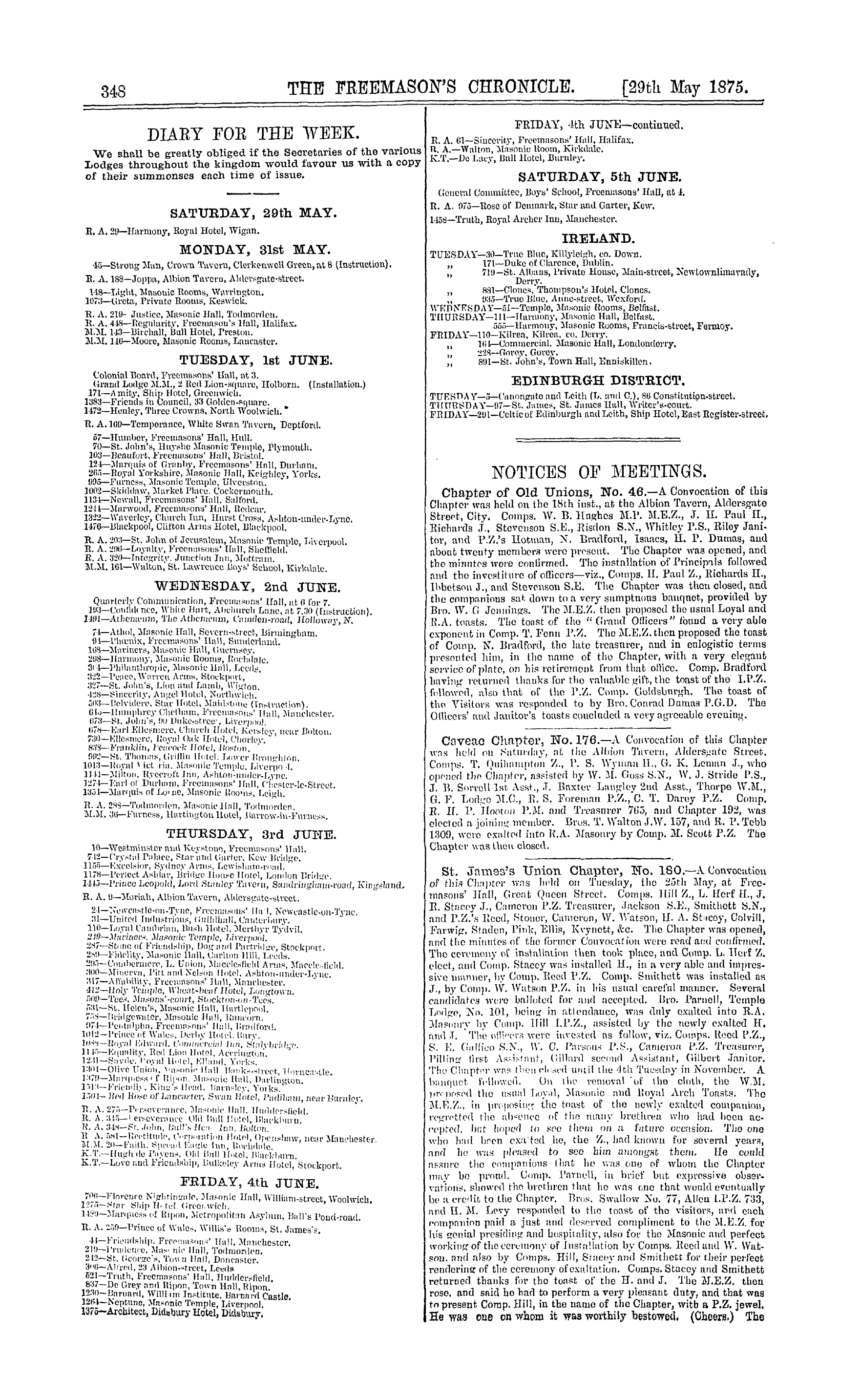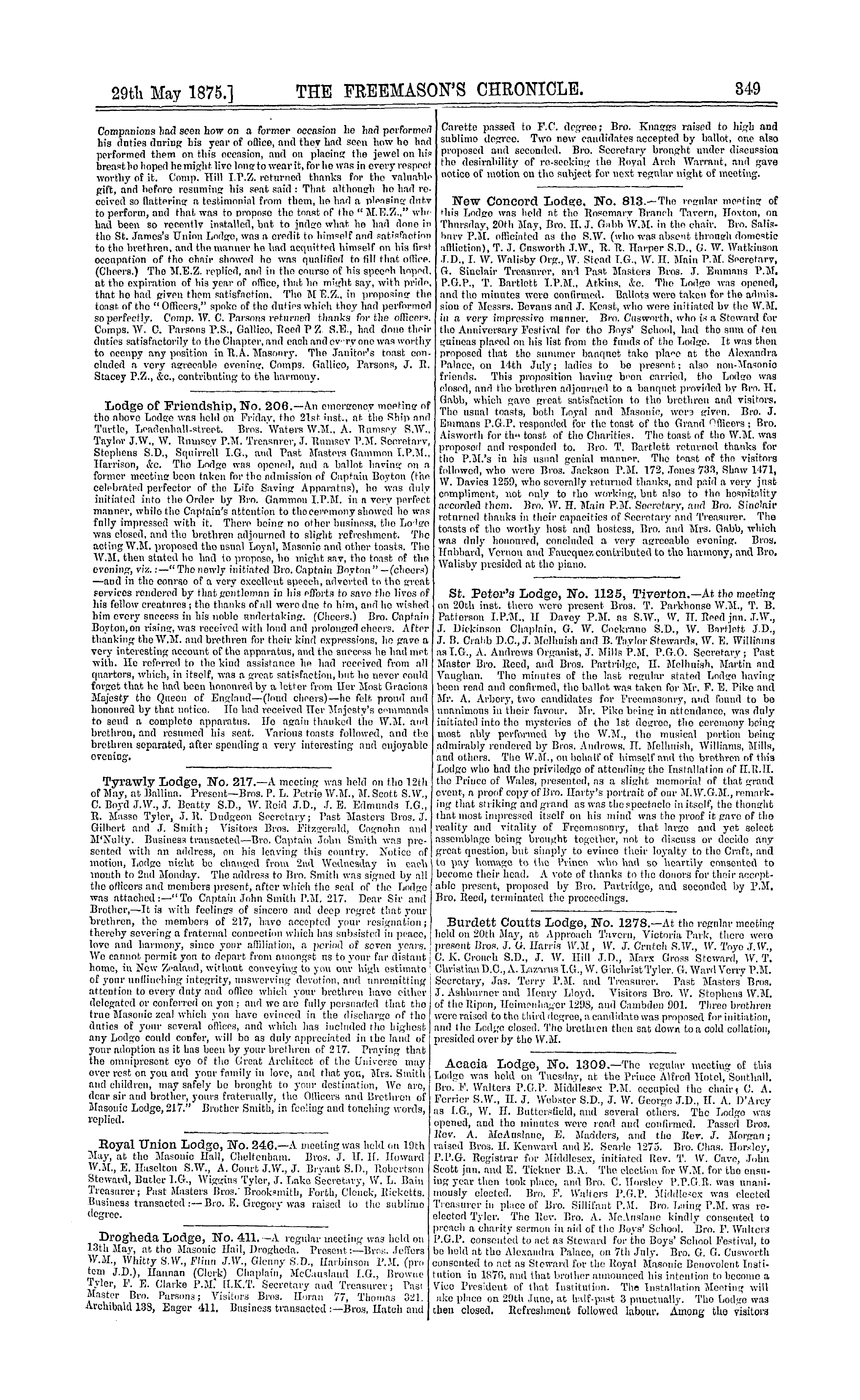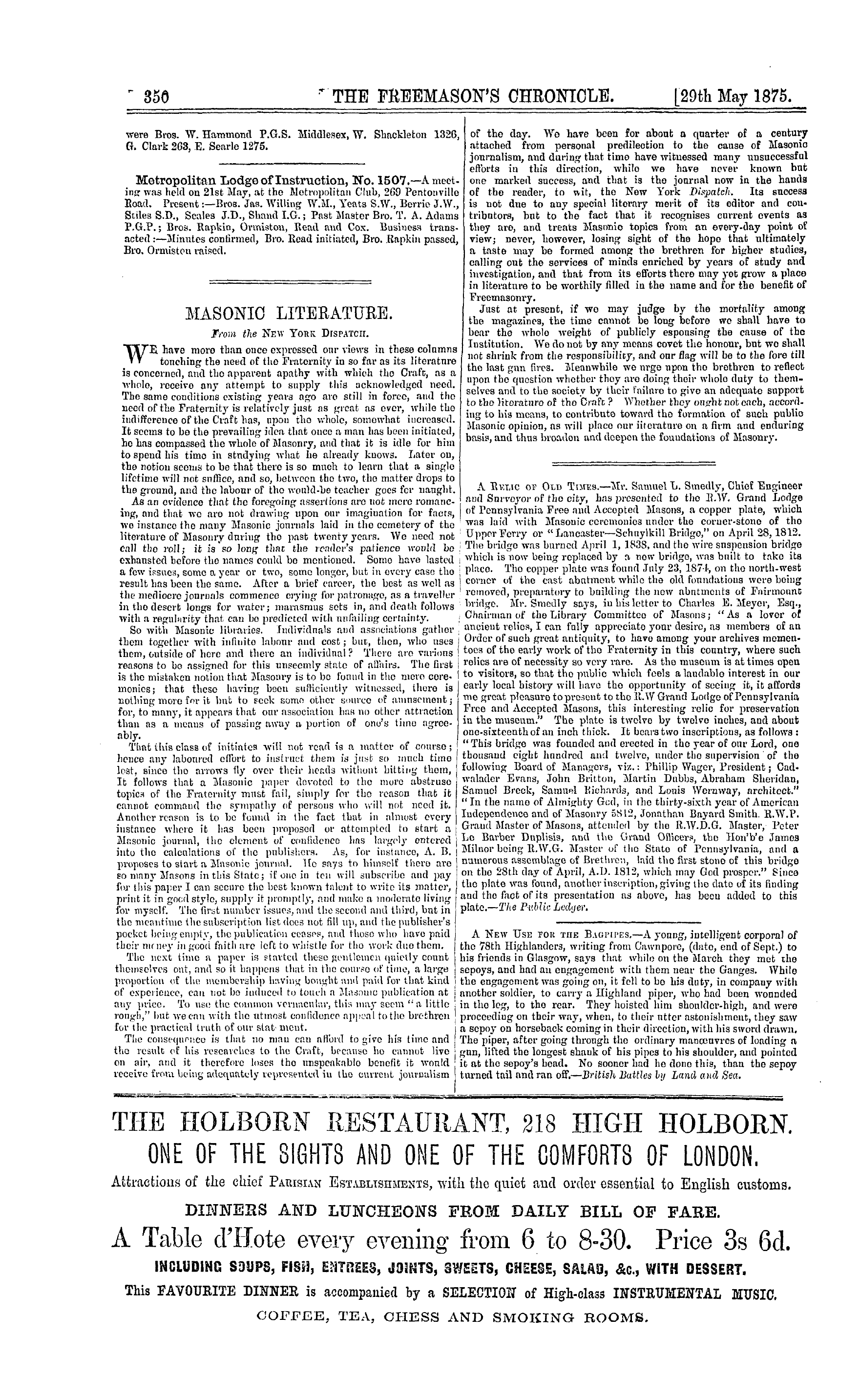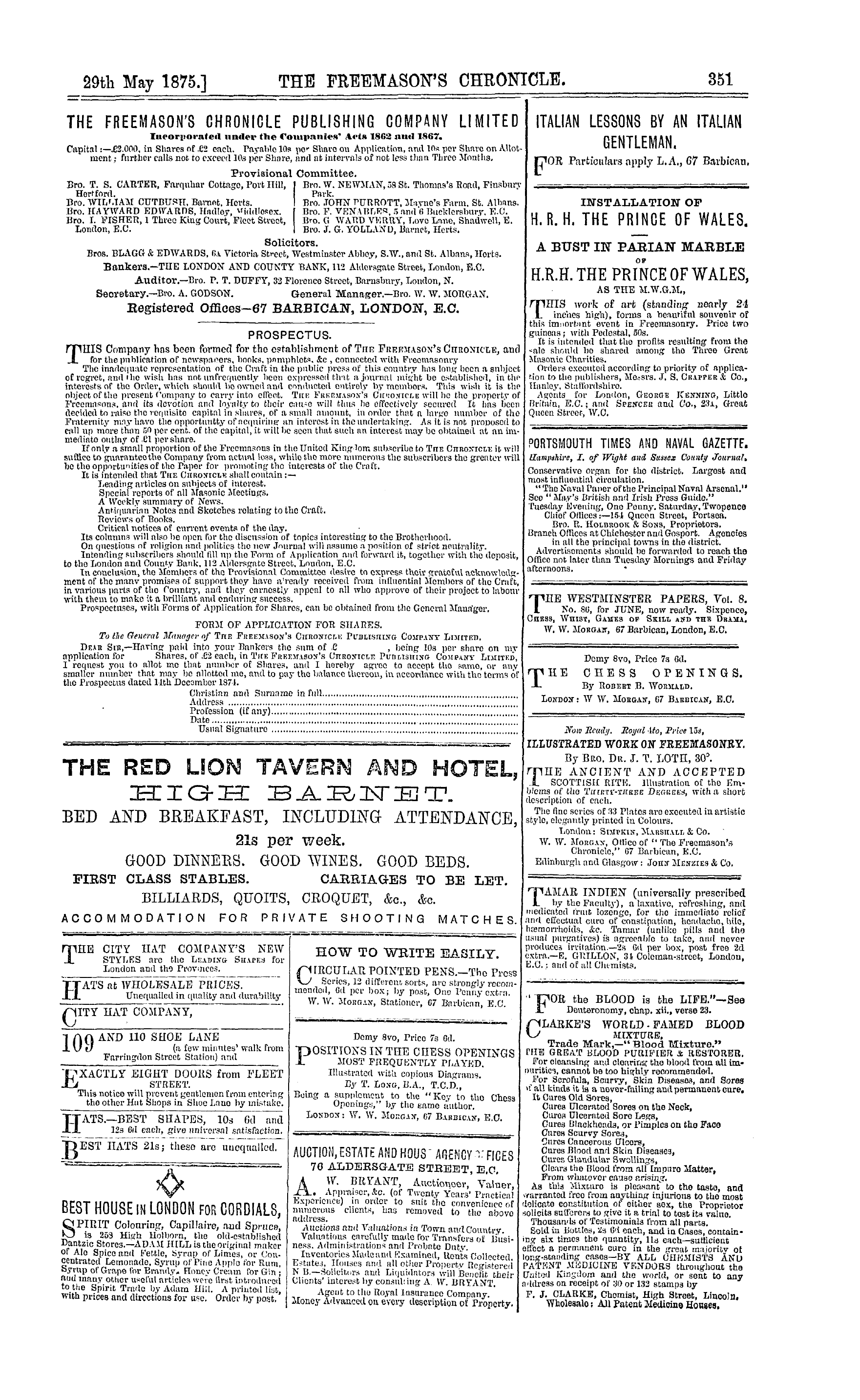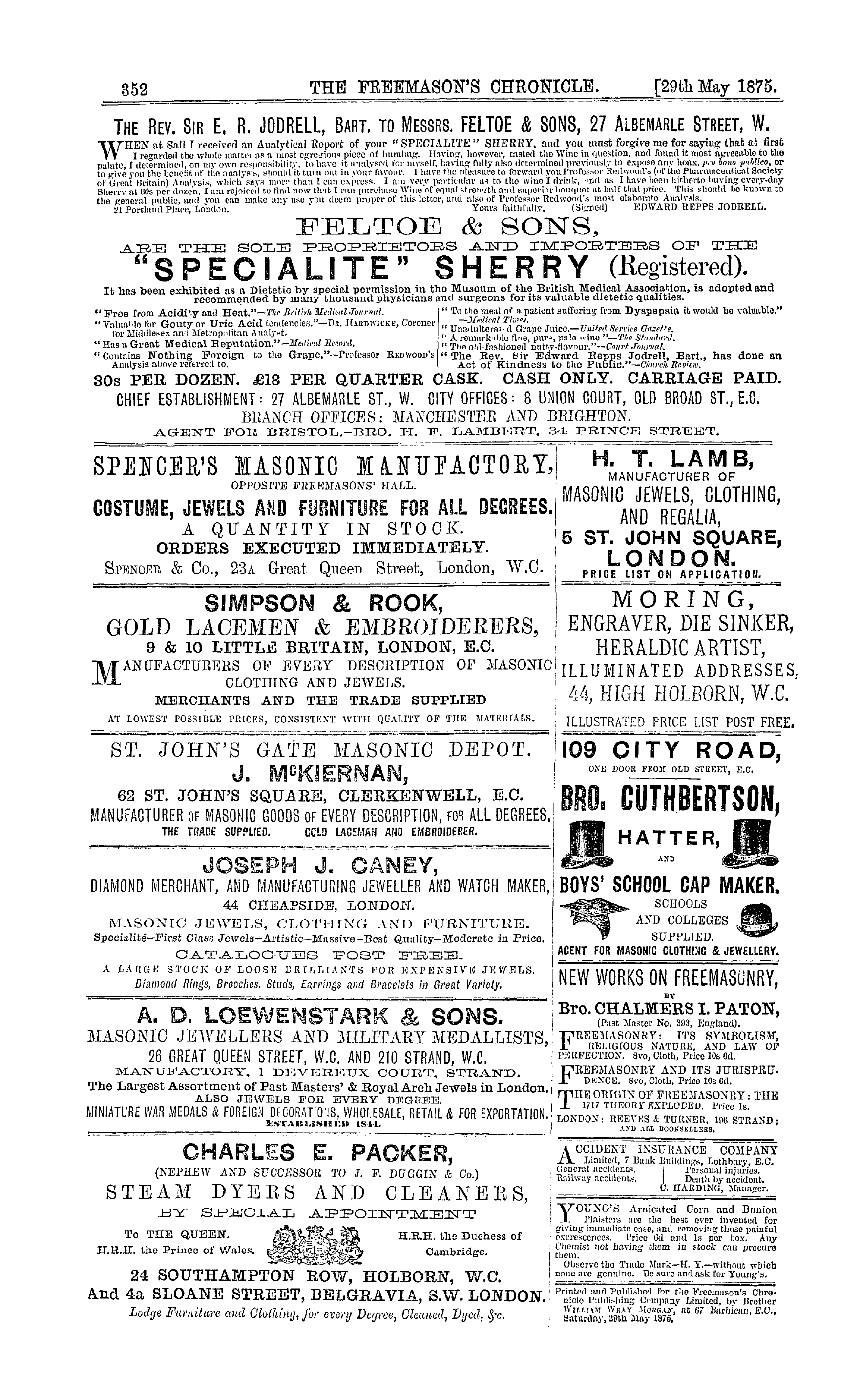-
Articles/Ads
Article THE 1717 THEORY. Page 1 of 1 Article THE RIGHT OF VISITATION. Page 1 of 2 Article THE RIGHT OF VISITATION. Page 1 of 2 →
Note: This text has been automatically extracted via Optical Character Recognition (OCR) software.
The 1717 Theory.
THE 1717 THEORY .
THE discussion fraternally carried on among modern Freemasons as to the antiquity of our Ritual , seems narrowing to a point , and turns upon the sources whence the 2 'evivalists of 1717 derived the system they transmitted to us . Theorists suppose that manv old stores were ransacked , besides that of the Society of Freemasons . If
the documents which , it is recorded , were burned at the time by scrupulous brethren could be now forthcoming , the question might be of easy solution ; but in their absence ,
fashionable scepticism finds scope for critical exactions , such as disturb the theologians of the day . Meantime tradition ( no light weight ) is on our side , and the assertion that our system is adoptive not ancestral , remains assertion only .
The crystallisation of Ritual into methodic degrees , supposing such was the work of James Anderson and Dr . Desaguliers , does not warrant the assumption that our Society was thereby severed from its foundation . The existence of a speculative system among early
Lastern Masonic Associations is historically proved , and traces of the immigration to this country of those artificers abound . At the meeting of the Society of Antiquaries , Feb . 10 th 1814 , was exhibited a drawing of two ancient wooden figures , which came from the old Manor House of
Wooburn in Buckinghamshire . Tho figures , life size , represent two Masons , old and young , the former , bearing a Quadrant and Staff , tho latter a Square and Compasses . The attire , head-dress , and even the features denote Asiatic originals ; their date the period of the Crusades *
Of the building secrets of the old Masons disjecta membra remain in our Ritual , which , we believe , to be of immemorial antiquity , and which may yet afford a clue to the canon of proportion of the ancients—embracing architecture , geometry , astronomy , maybe all the sciences . The roof
of King ' s College Chapel , Cambridge , was constructed by a rule that may yet be re-discovered in our symbolism . It seems superfluous to remark in this connection that the
Architects ( or Engineers ) of to-day are not the equals of the ancients in constructive power , and that without the wonderful facility of iron , their grandest works would make a sorry figure .
The Right Of Visitation.
THE RIGHT OF VISITATION .
MORE than once have we been asked to explain our views as to the reception of strangers in a Lodge . Only last week a correspondent in Australia submitted for our decision a case in which the rights of visitors were involved . Hence wo have thought it better to treat the
matter editorially at some length . Attheoutset the law seems precise enough . It is laid down , firstly , " that no visitor shall be admitted into a Lodge , unless he is personally known , recommended , or well vouched for , after due examination , by one of the present brethren ; and during
his continuance in the Lodge he must be subject to the byelaws of the Lodge . The Master of the Lodge is bound to enforce these regulations . " In the next place , " it is within the power of the Master , Wardens , and brethren of every private Lodge to refuse admission to any visitor of known bad character . " And finally , " a brother , who is not
* We have consulted , among other works , Velthusen , Einfluss Juden , " Chaldaiir , u Hebraer in Begleitung Phonizischer Seefahrer , & e . ( 1801 . )
The Right Of Visitation.
a subscribing member to a Lodge , shall not be permitted to visit any Lodge in the town or place where he resides more than once during his secession from the Craft . " There is nothing doubtful in these regulations . In the first place the Masonic character of the visitor must be proved . Then
the authorities of a Lodge may exclude a visitor who is of known bad character , and , finally , if the visitor is not a subscribing member to any Lodge he can only exercise his right of visitation at any Lodge once during his secession . The terms , then , of tho law are defined strictly , yet in
practice there is a divergence of opinion as to its application . Some hold that every M . M . who is a subscribing member of a Lodge , duly constituted , can exercise his right without restriction , while others regard the exercise of the right with jealousy . The late Dr . Oliver , than whom we
imagine no Masonic writer ever existed who takes a more liberal view of the rights and privileges of Masonry , devotes several pages in his Masonic Jurisprudence to the consideration of this question , and , like all liberal-minded men , he treats the matter in a broad commonsensible point of view . There
is no one in fact whose dicta on this or any other subject are more worthy of our respect , and accordingly we do not hesitate to pin our faith to his most lucid exposition . We make this admission the more readily that we find our esteemed Brother Chalmers I . Paton proposes the same , or at all
events , very similar views . Here then is what the late Bro . Oliver says . The laws , he points out , are stringent , but it is often found to be expedient to relax this stringency . A visitor must make clear his identity to the satisfaction of the Lodge he proposes to visit . He must
show that he is a subscribing member of some regular Lodge . If not known , or recommended by any wellknown brother , he must submit himself for examination by some experienced member , and having given satisfactory evidence of his Masonhood , he then becomes eligible for
admission into the Lodge during the transaction of Masonic business . But clearly the right should be exercised with discretion , while the propriety of the restriction imposed by law is self evident . A Mason , for instance , who is not a subscribing member of any Lodge , yet claims to exercise this
right of visitation , evades the most important of his Masonic duties . He will attend a Lodge without contributing to its expenses , and will be a burden to the brethren who compose it . Again , a Mason who happens unfortunatel y to be on unfriendly terms with any member of a
Lodge should clearly not press his claim to admission , for in such case he would destroy that harmony which it is the aim of Masonry to establish . Certainly , if of two members of a Lodge , whose relations towards each other are unfriendly , it is desirable that one should avoid being
present , it is still more important that a visitor whose unfriendliness towards some member is established , should forego his rig ht of visitation . He makes no sacrifice by doing so , while , on the other hand , his insistence virtually deprives the member affected of his rights of membership .
Again , no brother should press his claim to be present when the private business of the Lodge is under discussion . To do so were in the highest degree indelicate . The privacy of a Lodge should no more be invaded than the privacy of an individual . Our late Bro . Oliver mentions
that at a Quarterly Communication held in 1819 , a report from the Board of General Purposes was read , in which it was stated that a complaint had been submitted to them to the effect that certain brethren , though well known , had
been refused admission to a certain Lodge in London , on the ground that a candidate was about to be initiated , and the Board laid it down that it was the inherent right of every Mason , who is known or vouched for , to visit any
Note: This text has been automatically extracted via Optical Character Recognition (OCR) software.
The 1717 Theory.
THE 1717 THEORY .
THE discussion fraternally carried on among modern Freemasons as to the antiquity of our Ritual , seems narrowing to a point , and turns upon the sources whence the 2 'evivalists of 1717 derived the system they transmitted to us . Theorists suppose that manv old stores were ransacked , besides that of the Society of Freemasons . If
the documents which , it is recorded , were burned at the time by scrupulous brethren could be now forthcoming , the question might be of easy solution ; but in their absence ,
fashionable scepticism finds scope for critical exactions , such as disturb the theologians of the day . Meantime tradition ( no light weight ) is on our side , and the assertion that our system is adoptive not ancestral , remains assertion only .
The crystallisation of Ritual into methodic degrees , supposing such was the work of James Anderson and Dr . Desaguliers , does not warrant the assumption that our Society was thereby severed from its foundation . The existence of a speculative system among early
Lastern Masonic Associations is historically proved , and traces of the immigration to this country of those artificers abound . At the meeting of the Society of Antiquaries , Feb . 10 th 1814 , was exhibited a drawing of two ancient wooden figures , which came from the old Manor House of
Wooburn in Buckinghamshire . Tho figures , life size , represent two Masons , old and young , the former , bearing a Quadrant and Staff , tho latter a Square and Compasses . The attire , head-dress , and even the features denote Asiatic originals ; their date the period of the Crusades *
Of the building secrets of the old Masons disjecta membra remain in our Ritual , which , we believe , to be of immemorial antiquity , and which may yet afford a clue to the canon of proportion of the ancients—embracing architecture , geometry , astronomy , maybe all the sciences . The roof
of King ' s College Chapel , Cambridge , was constructed by a rule that may yet be re-discovered in our symbolism . It seems superfluous to remark in this connection that the
Architects ( or Engineers ) of to-day are not the equals of the ancients in constructive power , and that without the wonderful facility of iron , their grandest works would make a sorry figure .
The Right Of Visitation.
THE RIGHT OF VISITATION .
MORE than once have we been asked to explain our views as to the reception of strangers in a Lodge . Only last week a correspondent in Australia submitted for our decision a case in which the rights of visitors were involved . Hence wo have thought it better to treat the
matter editorially at some length . Attheoutset the law seems precise enough . It is laid down , firstly , " that no visitor shall be admitted into a Lodge , unless he is personally known , recommended , or well vouched for , after due examination , by one of the present brethren ; and during
his continuance in the Lodge he must be subject to the byelaws of the Lodge . The Master of the Lodge is bound to enforce these regulations . " In the next place , " it is within the power of the Master , Wardens , and brethren of every private Lodge to refuse admission to any visitor of known bad character . " And finally , " a brother , who is not
* We have consulted , among other works , Velthusen , Einfluss Juden , " Chaldaiir , u Hebraer in Begleitung Phonizischer Seefahrer , & e . ( 1801 . )
The Right Of Visitation.
a subscribing member to a Lodge , shall not be permitted to visit any Lodge in the town or place where he resides more than once during his secession from the Craft . " There is nothing doubtful in these regulations . In the first place the Masonic character of the visitor must be proved . Then
the authorities of a Lodge may exclude a visitor who is of known bad character , and , finally , if the visitor is not a subscribing member to any Lodge he can only exercise his right of visitation at any Lodge once during his secession . The terms , then , of tho law are defined strictly , yet in
practice there is a divergence of opinion as to its application . Some hold that every M . M . who is a subscribing member of a Lodge , duly constituted , can exercise his right without restriction , while others regard the exercise of the right with jealousy . The late Dr . Oliver , than whom we
imagine no Masonic writer ever existed who takes a more liberal view of the rights and privileges of Masonry , devotes several pages in his Masonic Jurisprudence to the consideration of this question , and , like all liberal-minded men , he treats the matter in a broad commonsensible point of view . There
is no one in fact whose dicta on this or any other subject are more worthy of our respect , and accordingly we do not hesitate to pin our faith to his most lucid exposition . We make this admission the more readily that we find our esteemed Brother Chalmers I . Paton proposes the same , or at all
events , very similar views . Here then is what the late Bro . Oliver says . The laws , he points out , are stringent , but it is often found to be expedient to relax this stringency . A visitor must make clear his identity to the satisfaction of the Lodge he proposes to visit . He must
show that he is a subscribing member of some regular Lodge . If not known , or recommended by any wellknown brother , he must submit himself for examination by some experienced member , and having given satisfactory evidence of his Masonhood , he then becomes eligible for
admission into the Lodge during the transaction of Masonic business . But clearly the right should be exercised with discretion , while the propriety of the restriction imposed by law is self evident . A Mason , for instance , who is not a subscribing member of any Lodge , yet claims to exercise this
right of visitation , evades the most important of his Masonic duties . He will attend a Lodge without contributing to its expenses , and will be a burden to the brethren who compose it . Again , a Mason who happens unfortunatel y to be on unfriendly terms with any member of a
Lodge should clearly not press his claim to admission , for in such case he would destroy that harmony which it is the aim of Masonry to establish . Certainly , if of two members of a Lodge , whose relations towards each other are unfriendly , it is desirable that one should avoid being
present , it is still more important that a visitor whose unfriendliness towards some member is established , should forego his rig ht of visitation . He makes no sacrifice by doing so , while , on the other hand , his insistence virtually deprives the member affected of his rights of membership .
Again , no brother should press his claim to be present when the private business of the Lodge is under discussion . To do so were in the highest degree indelicate . The privacy of a Lodge should no more be invaded than the privacy of an individual . Our late Bro . Oliver mentions
that at a Quarterly Communication held in 1819 , a report from the Board of General Purposes was read , in which it was stated that a complaint had been submitted to them to the effect that certain brethren , though well known , had
been refused admission to a certain Lodge in London , on the ground that a candidate was about to be initiated , and the Board laid it down that it was the inherent right of every Mason , who is known or vouched for , to visit any











